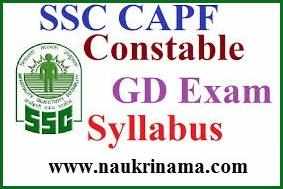SSC GD Constable Syllabus, Marks Distribution and Exam pattern 2015


Constables are empowered to enforce both criminal and civil laws. Police officers are empowered to enforce criminal and traffic laws. A Sheriff is the chief law enforcement officer of the County and is empowered to enforce criminal, civil, and traffic laws. Constable’s job is to serve and protect the community and to improve, maintain and ensure the quality of life for all.
Central Reserve Police Force is conducting common Recruitment of Constable/GD-2015 in CAPFs Written Exam. SSC GD Constable Written Examination will be held on 4 October 2015. You can check SSC GD Constable written Exam syllabus available here.
SSC GD Constable Syllabus, Marks Distribution and Exam pattern 2015
Name of organization: Central Reserve Police Force.
Name of post: Constable/GD-2015.
Date of examination: 4th October 2015
Exam pattern
- Type of Question: objective
- of Question: 100
- Time duration: 2hours(120 minutes)
Marks Distribution (section wise)
| Section | Subject | No. of question | Marks |
| First | General Intelligence & Reasoning | 25 | 25 |
| second | General Knowledge & General Awareness | 25 | 25 |
| Third | Elementary Mathematics | 25 | 25 |
| Fourth | English/Hindi | 25 | 25 |
Exam Syllabus:
The syllabus for the Constable (GD) written Examination is as follows:-
General Intelligence & Reasoning: Logical Reasoning means the process of forming Judgment conclusions from premises or facts. The question in this section may be based on Verbal and Non-Verbal.
- Similarities and differences,
- Spatial visualization,
- Spatial orientation,
- Visual memory,
- Discrimination,
- Observation relationship concepts,
- Arithmetical reasoning and figural classification,
- Arithmetic number series,
- Non-verbal series,
- Coding and decoding.
General Knowledge and General Awareness: It is known by everyone usually with reference to the topic in which the term is used. Common knowledge need not concern one specific subject, e.g., Science or history. Rather, common knowledge can be about a broad range of subjects, such as science, literature, history, and entertainment. Common knowledge is distinct from general knowledge
- Sports,
- History,
- Culture,
- Geography,
- Economic Scene,
- General Polity,
- Indian Constitution,
- Scientific Research etc.
Elementary Mathematics: consists of mathematics topics frequently taught at the primary or secondary school levels.
- Number Systems,
- Fundamental arithmetical operations,
- Percentages,
- Ratio and Proportion,
- Averages, Interest,
- Profit and Loss,
- Discount,
- Mensuration,
- Time and Distance,
- Ratio and Time,
- Time and Work, etc.
English and Hindi: Candidates’ ability to understand basic English/ Hindi, his basic comprehension would be tested.
English:-
- Spot the Error,
- Fill in the Blanks,
- Synonyms/Homonyms,
- Antonyms,
- Spellings/Detecting
- mis-spelt words,
- Idioms & Phrases,
- One word substitution,
- Improvement of Sentences,
- Active/Passive Voice of Verbs,
- Conversion into Direct/Indirect narration
- Shuffling of Sentence parts,
- Shuffling of Sentences in a passage,
- Cloze Passage,
- Comprehension Passage.
Hindi:-
- As usual errors of spelling words and words ,
- Words,
- Noun ,
- sentence in another sex change ,
- Idiom and their meaning ,
- purely impure sentences ,
- Vilomarthy words ,
- synonyms and synonyms ,
- polysyllabic words ,
- Meaning of proverbs and folklore
- Severance treaty ,
- the abstract noun to verb ,
- creation and the Creator ,
For Official Notice: CLICK HERE
To get more Exam Notification click here
For official website of CRPF: CLICK HERE
Central Armed Police Forces (CAPF) refers to uniform nomenclature of five security forces in India under the authority of Ministry of Home Affairs. They are Border Security Force, Central Reserve Police Force (CRPF), Central Industrial Security Force (CISF), Indo-Tibetan Border Police (ITBP) and Sashastra Seema Bal (SSB).
Central Reserve Police Force is the largest of India’s Central Armed Police Forces works under the aegis of Ministry of Home Affairs (MHA) of the Government of India. The CRPF’s primary role lies in assisting the State/Union Territories in police operations to maintain law and order and counter insurgency. It came into existence as the Crown Representative’s Police on 27 July 1939. Besides Law and Order and counter-insurgency duties, the role of CRPF in the General Elections, held repeatedly during the past few years, has been very significant and vital. With 230 battalions and various other establishments, the CRPF is considered India’s largest paramilitary force.
